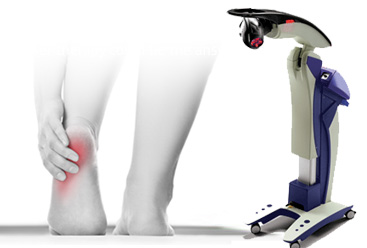
There is no need to live with heel pain!
Heel pain can be a truly debilitating condition, having a significant impact on your daily life. It can limit your ability to accomplish simple tasks like grocery shopping, walking the dog, or playing with your children or grandchildren.
It has been estimated that as many as 2 million people will experience plantar heel pain. Patients are typically between 40 and 60 years old, but the incidence is higher in individuals with an active lifestyle, runners, etc.
You may experience heel pain as the result of a number of different conditions, and for effective heel pain treatment to take place, it is important to diagnose the cause of your pain.
What is plantar fasciitis?
Although there are many different causes of heel pain, the most common cause is plantar fasciitis, an inflammation of a band of tissue that runs from the bottom of your heel to the ball of your toes. Plantar fascia pain can be quite severe and the pain is typically worse when standing on your feet after periods of rest. Patients typically experience pain in the bottom of the heel, but the pain can be anywhere along the bottom of the foot.
What causes heel spurs?
Heel spurs which are bony growths that can occur at the bottom of the heel, or in the back of the heel. These growths are typical at the point of attachment of either the achilles or the plantar fascia. A heel spur is not typically the source of pain but, pain results from increased stress on the tendon at the point of it’s attachment to the bone. Heel spurs can eventually become extremely painful depending on size and location making heel pain treatment a matter of urgency.
Tarsal tunnel syndrome
We’re probably all familiar with carpal tunnel syndrome which is a common cause of chronic wrist pain; however, you may have never heard of tarsal tunnel syndrome. This occurs along the inside of the ankle, and is the result of increased pressure on the posterior tibial nerve. This increased pressure may be the due to a number of different factors including varicose veins, cysts, or arch collapse.
Stress fractures: a break from your routine
Stress fractures may not be the result of one event like a fall, but may be caused by the culmination of repetitive stress on the heel. These fractures can also occur in the metatarsals, the longest bones in the foot. An intense or rigorous workout routine can cause small cracks or bruising of these bones.
What are the causes of Achilles Tendonitis?
Achilles Tendonitis may cause pain in the back of the heel, and is typically due to an overuse of the tendon. There may also be a spur at the point of attachment of the tendon. In worse case scenarios, there may be some tearing of the tendon. Posterior tibial tendonitis occurs along the inside of the ankle and along the side of the foot. On examination patients will typically have a lower arch, and are unable to stand on their toes.
Heel Pain Treatment
As each of these conditions is unique, each will require a different approach to treatment. In most cases your pain may be alleviated by implementing the right conservative heel pain treatment plan. Conservative treatments range from stretching, orthotics, physical therapy and laser therapy. In some cases injections may be warranted, and some cases will require surgery. Dr. Gowdie also employs painless laser therapy to treat heel pain.
If you are experiencing heel pain, we encourage you to contact us at The Foot and Ankle Treatment Center. Our competent staff is ready to answer any questions you have and to set an appointment to get you started on the path to recovery. Call us at (706) 310-4288 or complete our online appointment request form.
MLS Laser Therapy

MLS, or Multiwave Locked System, Laser Therapy is a noninvasive option for patients dealing with foot complications who want to explore treatment options other than surgery. MLS Laser Therapy helps relieve the pain that comes with having strains, sprains, and issues with inflammation. This therapy has been found especially useful for those who experience chronic complications.
Some foot conditions MLS Laser Therapy can treat include Achilles tendonitis, plantar fasciitis, heel pain, bursitis, diabetic neuropathy, and different forms of arthritic conditions. Those who are experiencing pain due to sporting injuries or wounds may also find relief with this kind of therapy.
MLS Laser Therapy is a painless treatment that typically requires a short amount of time to complete, depending on the condition. It not only increases the speed of recovery, but helps improve blood flow and alleviate pain. Improved immune function, as well as improved vascular and metabolic activity, are just some of the benefits of choosing MLS Laser Therapy as a treatment option. If you’d like more information about MLS Laser Therapy, consult with a podiatrist to determine if you’d be a good candidate.
